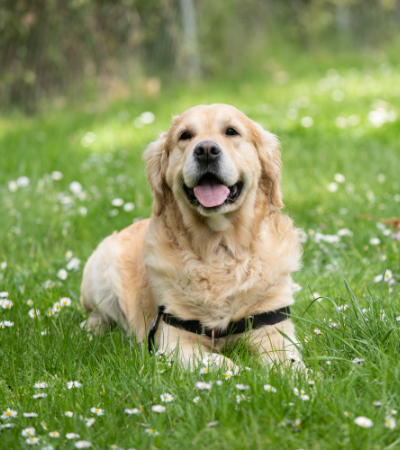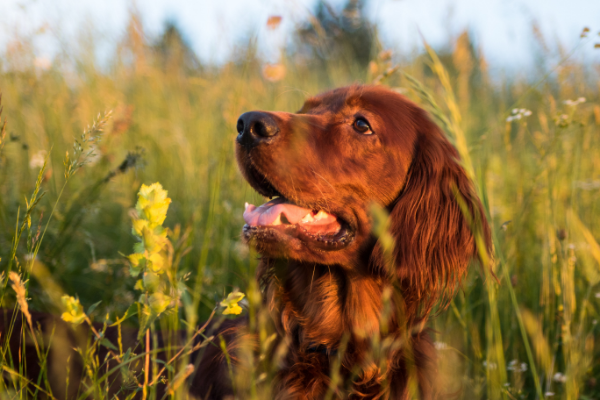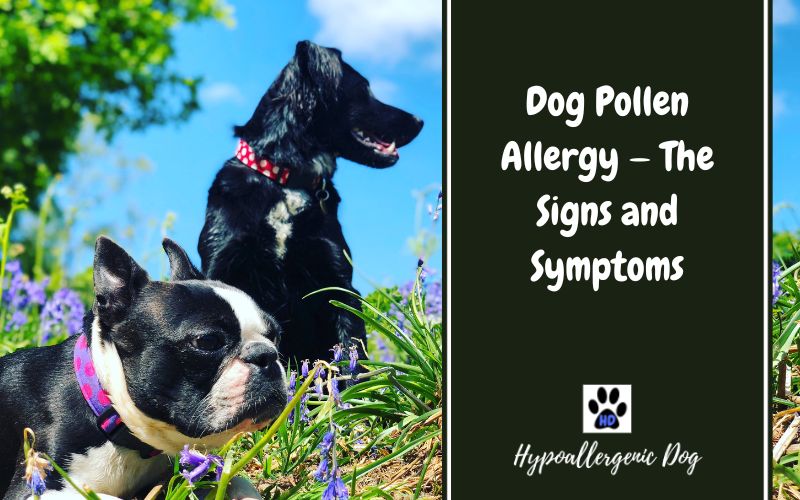Dog Pollen Allergy
If you suffer from pollen or seasonal allergies, you’ll know only too well how miserable it can make you feel. This applies to a dog pollen allergy too.
You will also understand how much of a difference the right preventative measures and medication can make to create a much happier experience during high pollen seasons.
The same can be said for your furry friend.
Pollen allergies in dogs are more common than you think and can develop at any point during your little buddy’s life. Plus, certain breeds are more susceptible than others due to genetics.

A pollen allergy in dogs doesn’t usually appear until after their first year of life, and female bow-wows are more prone to this condition. Plus, dog allergies to pollen are found more commonly in certain breeds. Hence, if you want to avoid these issues or are wondering if your current furry companion is at risk, here’s a list of breeds susceptible to pollen allergies:
- Bichon Frise.
- Dalmatians.
- Setters.
- Terriers.
- Boxers.
- Shar Pei.
- Pugs.
- German Shepherds.
- Cocker Spaniels.
- Schnauzers.
- English and French Bulldogs.
If you want to prevent the risk of a reaction, you need to limit the number of risky scenarios your dog is involved in when pollen is at its highest.
You can’t prevent your dog from developing allergies, but there are some things that you can do to help reduce the effect of pollen on their day-to-day life.
- Check daily pollen forecasts — Pollen seasons tend to be at the highest levels during spring and summertime, but it can take some time for it to tail off during autumn.
- Try to figure out the offending dog allergy to pollen type — Flowers, grass, trees, and weeds contain pollen. Once you’ve figured out the culprit, change your walkies route and steer clear of those places.
- A quick wipe down after walks — Wiping your dog’s coat and paws with a damp towel to remove pollen and dander several times a day can help prevent the pollen from irritating their skin and coat.
- Place a dirt trapping mat in your entrance — While dog dirt mats are typically associated with muddy/wet paws, they also attract and trap dust, pollen and other dry detritus.
- Using a shampoo — If you’ve noticed redness and irritation, use a hypoallergenic shampoo and conditioner. And, a spray containing aloe and oatmeal will also help to soothe the skin before it becomes too dry and uncomfortable.
- Regular washing — Try to clean your dog’s bedding frequently to prevent pollen from building up on it.
- Use a supplement — Another useful preventative measure is to give your dog supplements or probiotics to keep them healthy and in the best condition.

Dog Pollen Allergy Symptoms
There are several ways you can spot a dog pollen allergy. When the warmer seasons arrive — spring and summer — you may find there are dogs allergic to pollen whose symptoms worsen. These are the peak times when pollen causes issues for anyone with an allergy.
If your dog displays one or more of these symptoms, and they seem to intensify during the time of higher pollen counts, talk to your vet. Also, ask them to carry out tests to rule out any other underlying health issues first.
Hair Loss
If your dog’s allergies are left without treatment, it can cause their hair follicles to become inflamed from constant scratching and irritation. This type of trauma could lead to their hair falling out — leaving patches of sore exposed skin, which may become permanent if left untreated for a long time.
Red, Smelly Ears
Although you mainly see allergies affecting a dog’s skin, inflammation in their ears is not uncommon. Without treatment, infection is highly likely. You may pick up an unpleasant odor coming from their ears before you see the redness. However, the discomfort will be noticeable, as they frequently shake and paw at their ears for relief.
Puffy/Runny Eyes
Take a look at your dog’s eyes after they’ve been outdoors. Exposure to pollen often causes puffy or watery eyes. Hair loss may occur around the eyes as well as inflammation, or a green/yellow discharge.
Hives
After being in contact with pollen, you may notice your dog’s skin breaks out in rashes and hives. These itchy welts can remain for days or even weeks in some cases, which is why you should make sure you treat them as soon as possible.
It will be easier to spot any changes to your pup’s skin on areas with less hair coverage, such as their stomach, face, armpit, and legs.
Scratching
This symptom may develop while outdoors or shortly after coming inside. It may only be a mild persistent itching, but can also be quite an intense scratching as a dog allergy to pollen causes your pooch some serious discomfort.
In some cases, the excessive scratching may drive your pooch to begin biting and gnawing at their skin to try to find some relief from the constant irritation. Persistent licking is another way your dog can try to relieve the itching.
Dog Pollen Allergy Treatment
No one wants to see their furry friend suffer, so if you suspect a dog pollen allergy, you should call your vet as soon as possible. This will allow them to perform tests and decide on the best dog pollen allergy treatment.
Mild cases may be treatable by using a variety of at-home natural remedies. However, if your dog’s condition is severe, prescribed medication may be required to alleviate the symptoms and/or complications stemming from the allergy.
Medication
Use allergy-alleviating medication like Benadryl (antihistamine). But, bear in mind, you should do this under the advice of your vet, as the dosage for humans differs completely from a pet. If you want to know more about this form of treatment, check out our guide on Benadryl for Dog Allergies.
If your dog is suffering from a more serious case of pollen allergies, a stronger medication may be the solution. Your vet may wish to prescribe steroids in the form of injections or tablets to prevent your dog from further discomfort.
Medicated shampoos can also be used. These topical treatments not only soothe any irritation your dog may be feeling, but they also help treat right down into the hair follicle — preventing hair loss. Learn more in this Dog Shampoos for Allergies guide.
Natural Remedies
If your dog only suffers occasionally from pollen, you may want to use some natural dog allergy remedies at home. These can help prevent the symptoms before they cause too much stress for your pooch.
Coconut oil has antibacterial properties that reduces the sensation of itchy skin your pooch may be suffering from thanks to dog pollen allergies. Another option is a gel form of aloe vera. It will be a great help for your dog as it also has anti-inflammatory properties and will soothe hot spots and itches.
Fish oil for dogs supplements may benefit your furry friend. They improve your bow-wow’s immune system and overall health. Hence, by giving them all year round, your pooch stands a better chance of not experiencing uncomfortable dogs allergic to pollen symptoms.

Conclusion
While the summer season often means enjoying the great outdoors, pollen allergies can put a damper on the fun for some four-legged friends.
However, there are steps you can take to help your pooch. Plus, there are treatments for a pollen allergy in dogs you can try at home, as well as from the vets.
If your furry friend is suffering from a dog pollen allergy, preventative measures are your first line of attack. So, make sure their symptoms don’t develop into anything too uncomfortable and avoid that trip to the vet.
Can Dogs Have Allergies to Pollen?
Yes. Treatments are similar to what humans are given — antihistamines, steroids, etc. That said, reducing your dog’s exposure to pollen is often the best plan of action.
How Do I Know if My Dog Has Allergies to Pollen?
Dogs with a pollen allergy often display symptoms, such as hives, excessive licking, some hair loss, skin issues, puffy eyes, or smelly, sore ears.
What Time of Year Do Dogs Get Allergies?
Late summer up to early fall is typically when there is an increase in dogs with seasonal allergies.
What Can I Give My Dog for Pollen Allergies?
The treatments available for dogs with an allergy to pollen include:
- Medications such as Benadryl.
- Use of shampoos to soothe skin irritation.
- Avoid walks at certain times of the day.
- Ensuring paws and face are wiped clean after being outside.
How Does Pollen Allergy Affect Dogs?
Although dogs can suffer from a pollen allergy in the same way as humans, it affects them differently. Humans become sneezy and wheezy, while dogs become itchy and scratchy.
Why Do Dogs Have Allergies to Pollen?
Dogs develop allergies to pollen in exactly the same way as humans do — it’s an overreaction in the immune system.


